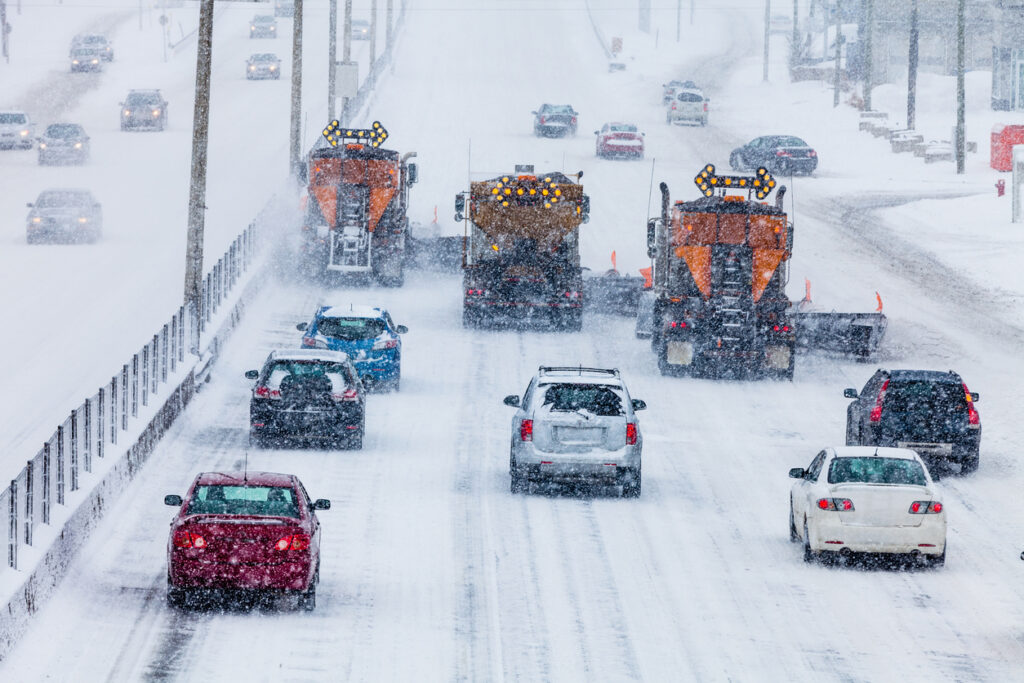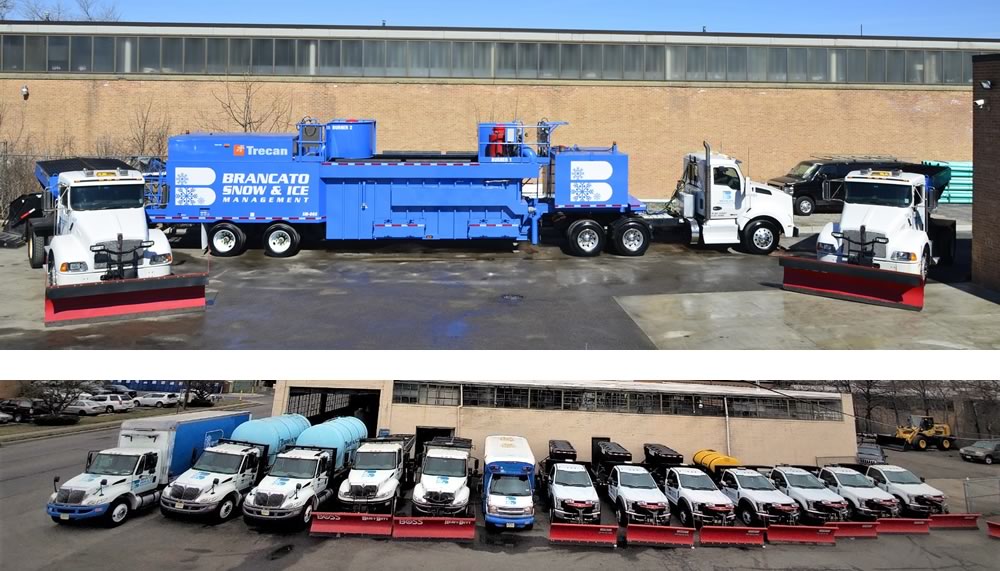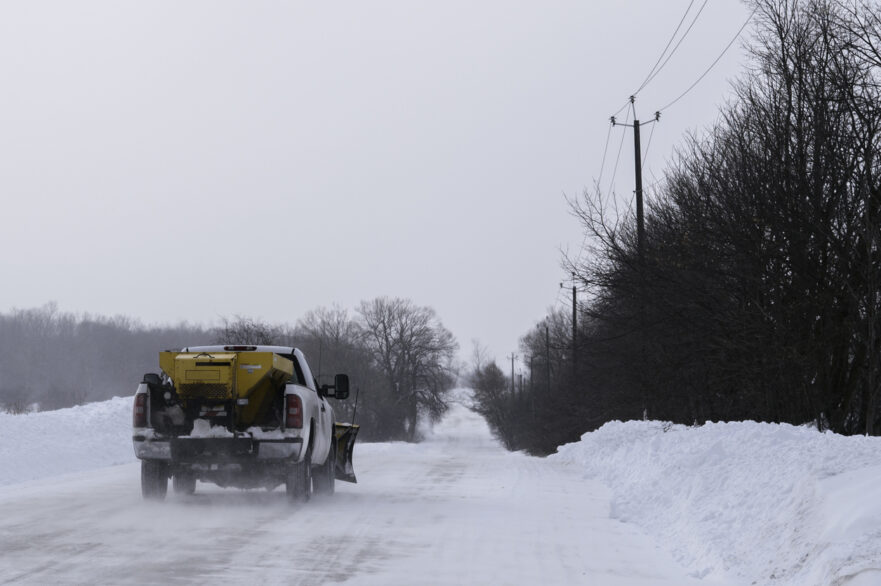Don’t let the distractions of life keep you from protecting your business with a snow removal services contract with Brancato!
Snow Removal Services Are Sometimes Lost In The Busyness
Sometimes the busyness of life distracts us from the important things. We move through our daily routine of groceries and children’s activities, and we forget about the hazards of doing business in the winter months. As we shuttle kids from school activities, then to summer activities, and then get ready for school again, our busy schedules reign. Even the noise of national events drowns out the cries of more practical concerns. This feels like a fairly modern problem to have, but this problem existed long before the tyranny of our cell phones and modern schedules became the norm. Let’s take a look at the year 1929, which began with a gray sky and light snow but ended with one of the biggest (and most forgotten) snow storms in Chicago history.
A Violent Start
The year 1929 was memorable for Chicagoans for many reasons, but primarily for how it began and ended. The year began as most do in Chicago, cold and dreary. Snow removal services were in their infancy back then, so most people gave it no time. As the year moved into a snowy February, the tension between the mobsters in Chicago came to a head. As light snow fell over the busy city on Valentine’s Day morning, seven Irish members of the Irish-Polish North Side Gang were brutally murdered in a garage in the Lincoln Park neighborhood.
Eleven men had gone into the garage that morning, but only four men walked out. The crime was shocking in both its severity and boldness. The crime was one of passion (none of the thousands of dollars in the garage was taken). It struck at the heart of one of the most powerful gangs in the US, although it has never been conclusively determined if that was the purpose of the attack or was incidental.
The investigation distracted Chicagoans that desperately wanted to hear that the violence was going to stop. Federal agents focused in on Al Capone as the prime suspect for ordering the hit. There was no evidence to link him to the crime, however. Soon the trail went cold and no one was ever accused or convicted of the crime. Bugs Malone, whose men were the ones gunned down, lost his most powerful lieutenants that day. His gang faltered and Moran slowly lost his power in Chicago and left.
Transitions To More Pleasant Things
Nevertheless, the attack marked the end of popular support for the Prohibition Era policies that had led to the gangland violence that characterized Chicago in the eyes of the nation. Within weeks, a new president was in the White House. Keen to establish that his administration was going to be tough on crime, the FBI doubled down on the gangs. Meanwhile, public sentiment had eroded in their support of prohibition. Within four years the 18th Amendment was struck down, Al Capone was behind bars (for other crimes), and Bugs Malone was irrelevant.
All that would come in time. But in early 1929, the grisly murders held everyone’s attention. Within weeks the general public grew weary of the stressful subject and yearned for more peaceful conversations. After all, there were better things to fill the days. The ponds and outdoor skating rinks thawed and the toboggan ramps melted away. Boys began to dream of baseball and fishing the ponds and rivers around the city. Winter was not to be so easily forgotten, however.
A Snowy May
April was uneventful and warm. Fruit trees began to blossom and flowers bloomed. Chicagoans were eager to throw off the grim and chilly winter. This race toward summer would have to be postponed for a day, however. On May 2nd a freak spring snow storm dumped up to five inches from St Louis, MO to Chicago. Trees were weighed down with heavy snow and many broke under the load. High winds contributed to the problem. Damage to the fruit orchards and crops throughout Illinois totaled over $400,000. The final assault from winter was brief, however. The snow that flew so prolifically that morning was already melting that evening. The late Spring warmth reasserted itself and the region moved again toward an active Summer.
Summer Swings Into Motion
With Summer comes the crack of the baseball bat and the smell of hotdogs and mustard. Wrigley field had become a mainstay of the Chicago sports scene and 1929 marked fourteen years of games there. The Chicago Cubs enjoyed one of their best seasons on record and easily moved into the World Series. Fans came from all over to watch their victories during a 98-54 season, making them the favorites to the chagrin of the less successful White Sox.
Families eased the heat of the summer in the many parks of the Windy City. Walks on the Navy Pier and along Lake Michigan provided relief, as well. Boys and girls found distractions with summer jobs and the many service organizations that grew in popularity in the 1920s.
Among the distractions were the new theaters that were opening throughout the city. On July 13th, Warner Bros introduced the first all-color “talkie”, On With The Show. In August those theaters began showcasing the first of Walt Disney’s Silly Symphonies, which was a cartoon series combining animation and music. Comedies were also a favorite on the silver screen. As a result, the careers of Laurel & Hardy, Buster Keaton, and the Our Gang kids flourished.
A Grim Fall Grips The Nation
Soon Summer gave way to Fall. Children went back to school. The parks and theaters quieted down as the days grew cooler. As families went back to their normal routine, the economic situation began to grow tense.
The United States had entered the 1920s as the most economically strong nation in the world. The infrastructure and population of Europe had been devastated by “The Great War”. Even Great Britain, which had been spared the destruction of the mechanisms of war, was reeling from the loss of so many young men during the conflict. The United States had come late to the war and saw no fighting on its soil. However, the nation had geared up to provide the instruments of the destruction and profited from both the war and reconstruction of Europe. The nation continued to industrialize, drawing more people from the rural areas. Immigrants from war-torn countries also came to America’s cities, increasing our workforce.
A Black October
In the spring of 1929, there were signs that those heady years of unprecedented economic growth were coming to an end. Questionable trading and loan practices had made America’s economic state unstable. Even with a small crash in March of the year, stock speculation continued unchecked. Most people refused to believe that the economy of such a powerful nation could crash. But crash it did!
On October 28-29, 1929, the Dow Jones Industrial Average fell by over 23%. It was the largest economic collapse in the nation’s history. It would take 25 years to regain the closing index from the highest traded day prior to the crash. The result was a loss of over 50 billion dollars in the space of the next two years and the worse economic depression in American history. The effects were felt across the globe.
The immediate effects of the stock market crash were felt more acutely in the major cities. Over 5,000 banks failed and by 1931 businesses were going under at the rate of 133 per day. While these effects didn’t happen immediately in 1929, the increasing unemployment rate was obvious by the end of the year. Thanksgiving was marked by rising anxiety. As November gave way to December, there was little sign of a bustling Christmas, let alone a white one. As temperatures held steady, the stores had decreasing traffic as the effects of the growing economic depression were felt. No one thought about winter storms or the need for snow removal services at all. Both, perhaps they should have!

The First Of Two Winter Storms
In mid-December, there were two winter storms that formed in different parts of the continent. In the northern reaches of Alberta, a low-pressure system formed that pulled cold arctic air down as it tracked quickly down toward the southern tip of Lake Michigan. It brought frigid cold and heavy snow as it tore across the Great Plains toward Chicago, challenging even the most hearty snow removal services.
The weather had been unseasonably warm ahead of the storm. Cold air pushed ahead of the precipitation, pouring in like a flood. As the temperatures dropped, so did the snow. Once the snow began to fall on December 17th it didn’t stop for almost two days. Strong north-northeast winds blew in across the farmland outside of Milwaukee and across Lake Michigan. Consequently, blizzard conditions were experienced across Chicago.
Wind gusts of over 50 MPH drove waves crashing on the shore and the snow into drifts from four to eight feet high. The waves caused damage along the shoreline and flooded neighborhoods adjacent to the lake. The city’s traffic ground to a halt. Streets were impassable throughout the metropolitan area. The side streets would stay packed with snow for over a week. Additionally, the railroads were affected. Snow clogged switches, forcing the rail lines to stop their trains. Once stopped, the snow made it increasingly difficult to get them moving again.
When the snow stopped falling there was nearly 15 inches on the ground. There wasn’t much in the way of snow removal services in those days. What equipment there was didn’t start moving until the snow had stopped. Cleanup was tedious and slow. The cold air that had flooded the area kept the snow in place until after the first of the year. Children woke up on Christmas morning with at least ten inches still on the ground.
The First Leads Into The Second
The second storm did not start out as impressively as the first. Sliding in from the Rockies, it initially just brought colder temperatures to Texas on its way to the Deep South. That cold air was attention-grabbing, though. The temperatures fell 40 degrees in just 24 hours. Folks that were enjoying 70-degree day on December 16th found the thermometer barely reaching into the upper 20s by December 17th. December 18th was sunny but even colder. Residents of the Texas Panhandle hoped that the warm air they had enjoyed just a couple of days earlier would be back soon.
But as the front passed over the state it combined with the weather system coming down from Chicago. With the infusion of snow and colder air, the storm transformed into the worse snowstorm in recorded history for central Texas. Snow began to fall on the evening of December 18th and there was up to two inches on the ground in the Texas Panhandle by morning. As the storm moved south and further into the state, snow fell at an alarming rate. Within 48 hours of the temperatures beginning to drop, there was up to 26 inches of snow on the ground in parts of the state.
The snowfalls were wildly different in only a few miles. Waco recorded 13 inches of snow and 2-degrees as a low temperature. Clifton, only 35 miles northwest, had two feet of snow. Almost 100 miles to the northeast, Dallas only received a dusting of snow. Snow removal services in Texas were practically nonexistent. Residents of the Lone Star State were thankful that temperatures rebounded quickly, warming to the 70s for Christmas Day.
Remarkably Forgotten
In spite of the damage from the Chicago storm and the length of Chicago’s recovery, there is hardly any information about it out there. The other events of 1929 overshadow it. A new president, a violent end to a group of violent men, an economic crisis all are there, but only a few references to the eighth biggest snow storm in Chicago history. The final blow came from the storm that our storm helped make. If it wasn’t for the 1929 Chicago blizzard there wouldn’t have been the 1929 Texas Blizzard.
The events of 1930 would distract people all the more. When the snow plowing was done and the snow removal services folks had packed up their equipment after over a week, Chicago went back to the crisis that would dominate the headlines for years. The soup kitchens would slowly fill with families and the shuttered businesses would command attention. The distractions would creep in again.
Who Is Providing Your Snow Removal Services?
Don’t be distracted by that noise. Protect your business today! A snow removal service contract with Brancato will ensure that we have you covered no matter what winter weather is headed our way! Contact us today and get your free quote. Our sales staff are friendly and knowledgeable and would love to help you figure out how best to meet your snow removal service needs. After that, one of our service managers will set up a site visit and we will get the process moving forward quickly and easily!


